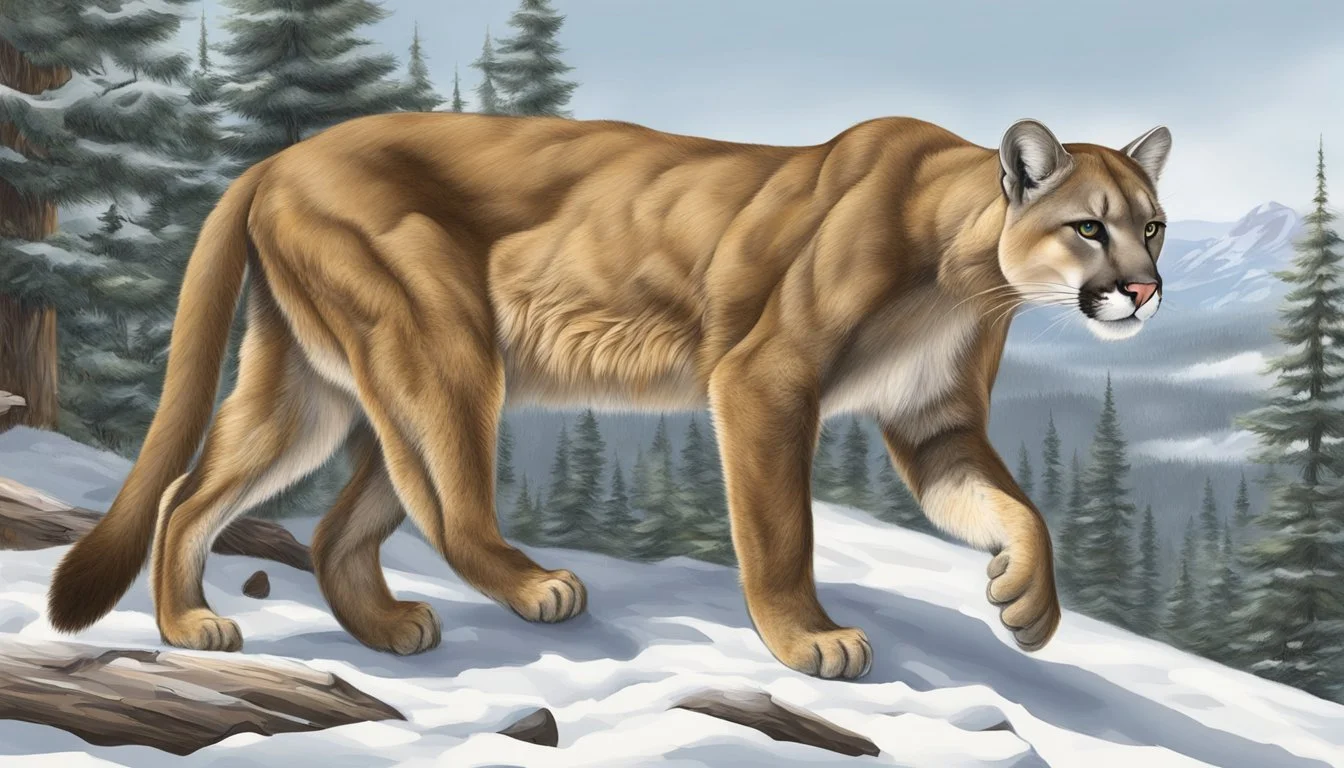Mountain Lion Hunting Seasons
Regulations and Best Practices
This Article is Part of Our Guide on Hunting Seasons for Over 70 Common Game Species
Mountain lion hunting seasons vary across the United States, reflecting the balance between wildlife management and conservation efforts. These elusive predators, also known as cougars or pumas, have specific hunting regulations that are closely monitored by wildlife agencies to ensure a sustainable balance within ecosystems. Hunting seasons are typically established based on scientific research, population dynamics, and the need to manage human-wildlife conflicts while preserving the species for future generations.
In some states like Arizona and South Dakota, mountain lion hunting may occur year-round, reflecting an assessment that the populations can sustain such a level of hunting pressure. Other states, including Wyoming and Utah, designate specific season dates, often dividing them into regions or management units for greater control. These restrictions both protect mountain lions and ensure that their populations do not adversely affect prey species, supporting overall biodiversity.
Regulations often require hunters to submit harvested animals for inspection and may involve mandatory collection of biological samples. This not only aids in the ongoing study of mountain lion health and population but also serves as a check to ensure the legality of the hunt. Striking a balance between hunting traditions and conservation underpins the carefully calibrated management strategies applied across varied habitats where these apex predators roam.
Mountain Lion Biology and Behavior
Mountain lions, also known as cougars or pumas, are complex creatures that exhibit unique behaviors linked to their ecological roles as apex predators. Their biology and habits are intricately connected to their environment and prey availability, which shapes their hunting techniques and conservation status.
Species Overview
Puma concolor, commonly known as the mountain lion, is a large felid native to the Americas. They have a wide range that extends from the Canadian Yukon to the southern Andes of South America, making them one of the most widespread carnivores in the western hemisphere. Mountain lion populations vary greatly across different regions.
Predation and Prey
Mountain lions are carnivorous predators that mostly hunt deer, including mule deer and whitetail deer, along with other large mammals like elk. They are solitary hunters that employ stealth and power to take down prey, typically every ten to fourteen days to sustain themselves.
Hunting Techniques of Mountain Lions
These big cats utilize stealth and ambush as primary hunting techniques, often pouncing from high vantage points onto their prey. The strike usually aims for the back of the neck to deliver a fatal bite, quickly immobilizing the targeted animal. Mountain lions may cover their kill with debris, returning to feed over several days.
Conservation Status
Conservation efforts for mountain lions are crucial as they face numerous challenges including habitat loss, hunting pressure, and conflicts with humans and livestock. Research and conservation programs focus on understanding mountain lion ecology to inform management practices and maintain viable populations.
Mountain Lion Habitats
Mountain lions occupy a diverse array of habitats from forests and mountains to deserts and wetlands. They prefer regions that provide ample cover for hunting and seclusion, which can range from lowlands to rugged terrain at higher elevations.
Mountain Lion Signs and Tracking
Tracking mountain lions involves looking for physical signs such as lion tracks in snow or mud, scat, and scratch marks on trees. Their tracks are distinguished by the absence of claw marks, as mountain lions, like all cats, have retractable claws.
Gender Identification
Distinguishing the sex of a mountain lion can be challenging but it is generally noted that males are larger with a broader head. Size of tracks and the spacing of urine marks can also offer clues, as males usually have larger prints and mark with urine more frequently and over a wider range than females.
Legal Aspects of Mountain Lion Hunting
The regulation of mountain lion hunting varies by state, focusing on sustained management and ethical practices. Hunters interested in pursuing mountain lions must navigate a complex landscape of legal requirements.
Understanding Regulations
Regulations are crucial for the sustainable management of mountain lion populations, with states like Colorado, Montana, Utah, Oregon, Washington, and Texas, each establishing their own rules. These rules are informed by scientific data and often include requirements for hunter education.
Permits and Quotas
Permits are mandatory, and hunters must possess a valid hunting license which may include a separate mountain lion tag or stamp. Quotas control the number of mountain lions that can be harvested, which helps to keep populations stable. For instance, Colorado set its 2023-24 season harvest cap at 674 animals.
Season Dates and Restrictions
Mountain lion hunting seasons can vary, with some states running seasons from December through March or specific months such as April. Restrictions may include canceling seasons to address conservation needs, as recently seen with Colorado’s cancellation of the April hunting season.
Weapon Regulations
Hunters are typically allowed to use rifles, bows, or firearms within specific regulations that could define minimum caliber or draw weight. States often prohibit the use of electronic calls to maintain ethical hunting standards.
Hunting Zones and Units
States divide hunting areas into zones or units which carefully manage through specific quotas. For non-residents, these zones may have different fee structures or permit availability, emphasizing fair opportunity and resource conservation.
Regulatory Bodies and Meetings
State wildlife agencies, such as the Colorado Parks and Wildlife (CPW) Commission, hold meetings to review and adjust hunting regulations. These bodies play a critical role in setting fees, defining seasons, and discussing management strategies to ensure the long-term sustainability of mountain lion populations.
Planning the Hunt
Successful mountain lion hunting relies on meticulous preparation, including the right equipment, choice of location, expert guidance, and scouting skills. Understanding these elements is essential for any hunter seeking to engage in this challenging pursuit.
Equipment and Gear
Hunters should equip themselves with a reliable firearm or bow. Rifles are commonly used, offering range and precision. It is advisable to use rifles with a caliber sufficient to ensure a humane kill. Hunters opting for a bow must practice to ensure accuracy, particularly at varied ranges. Essential gear includes a durable pack to carry supplies, adequate clothing for changing weather, and a treestand or ground blind if the hunting strategy requires waiting for the lion to pass by.
Choosing a Location
When selecting a location, hunters should consider states known for mountain lion populations, such as Montana, Oregon, Utah, Washington, and Texas. Regulations on mountain lion hunting vary from state to state, so it is crucial to understand and comply with all local laws and seasons. In some areas, hunting may coincide with snow conditions, which can assist in tracking due to visibility of lion tracks.
Guides and Outfitters
Especially for those new to mountain lion hunting, enlisting the services of a professional guide or outfitter can significantly increase the odds of success. These experts come with a wealth of knowledge about local mountain lion behavior, prime locations for hunting, and may provide additional resources, such as hounds, to aid in tracking.
Scouting Techniques
Scouting is fundamental and often involves looking for signs of mountain lions such as tracks, scrapes, and cached prey. Utilizing trail cameras can offer insights into lion movements and habitat use. Paying careful attention to the environment and understanding the behavior of local wildlife can enhance the hunter's ability to locate their target. Hunters should be prepared to cover large areas, as lions have vast territories and are elusive by nature.
Hunting Techniques
Mountain lion hunting requires a range of techniques tailored to the elusive nature of these large predators. Each method demands specific skills and preparation to ensure a successful and ethical hunt.
Using Dogs
In mountain lion hunting, the use of dogs, especially hounds, is a common technique. Trained hounds pick up the scent trail of a mountain lion and lead hunters to its location. Once located, the dogs may tree the lion, holding it in place until the hunter can arrive.
Stalking and Still Hunting
Hunters employ stalking and still hunting by moving silently and carefully through mountain lion habitat, searching for signs such as tracks or scratch marks. Patience and stealth are crucial, as mountain lions are highly alert and sensitive to their surroundings.
Archery Hunting
Archery hunters use bows to hunt mountain lions. This method requires close range and precise shot placement. Hunters practicing archery must have advanced skills in stalking to get within a viable distance for a clean shot.
Rifle Hunting
Rifle hunting is a popular choice for pursuing mountain lions due to the distance it allows between the hunter and the lion. Effective rifle hunting depends on the hunter's marksmanship and ability to accurately shoot from various ranges and conditions.
Mountain Lion Calls
Some hunters use calls to attract mountain lions by mimicking the sounds of prey or other lions. This method requires knowledge of mountain lion behavior and vocalizations. Calls must be used with caution, as they can also alert the lion to the hunter's presence.
Post-Hunt Procedures
Post-hunt procedures are essential for maintaining responsible wildlife management and conservation. They ensure that hunting activities contribute to scientific data collection while confirming compliance with established regulations.
Tagging and Reporting
After a hunter successfully harvests a mountain lion, they must tag the animal immediately with the appropriate permits they've received prior to the hunt. This tag often contains information such as the hunter's identification and the date of kill. Hunters are typically required to report their harvest to wildlife authorities within a prescribed timeframe, furnishing details such as:
Location of the kill
Gender of the mountain lion
Age, if ascertainable
This process aids in monitoring quotas and ensuring that bag limits are not exceeded. It also assists in making conservation and management decisions at commission meetings.
Conservation and Management
Information collected from tagging and reporting feeds directly into conservation efforts. It helps to:
Adjust hunting seasons to sustainable lengths
Align permits with current population data
Calculate future quotas based on the health of the mountain lion population
These measures guarantee that mountain lion numbers remain at levels that are ecologically stable and that hunting practices do not negatively impact the species' long-term viability.
Meat and Trophy Processing
After a mountain lion is harvested, processing the meat and any trophies is the next step. Hunters must conform to state regulations concerning the sale of meat and parts, with many states prohibiting such sales. Proper handling of the meat for consumption is important, as is the lawful handling of any part of the animal kept for trophies to comply with:
Sale and transport laws
Health guidelines for wildlife-derived products
Through these post-hunt procedures, mountain lion hunts are tightly regulated and managed to support wildlife conservation while providing a clear framework for the ethical pursuit and utilization of these apex predators.
Safety and Ethical Considerations
In mountain lion hunting, the safety of hunters is paramount, and ethical hunting practices are crucial for conservation. It’s essential that hunters are trained, prepared, and maintain reverence for these big cats throughout the hunting season.
Hunter Safety
Training and Preparation: Hunters are advised to complete safety training courses specific to big cat hunting before setting out. They should be proficient in using their equipment and familiar with the behavior of mountain lions to ensure they can make safe and responsible decisions in the field.
Companion System: Always hunt with a partner for safety.
Communications Plan: Have a reliable means to communicate with others, especially in remote areas where mountain lions are prevalent.
Ethical Hunting Practices
Fair Chase Principle: Hunters must engage in fair chase, which prohibits unfair advantages over the mountain lions, ensuring a sustainable and respectful hunt.
Regulatory Compliance: Follow all local regulations, including hunting seasons and bag limits to support conservation efforts.
Respect for the Animal: Hunting should be carried out with the utmost respect for mountain lions, aiming to reduce suffering and preserve the integrity of the species.
First Aid and Wilderness Survival
Medical Preparedness: Hunters must carry a comprehensive first aid kit and know how to use it. Familiarize oneself with common injuries and conditions that could occur in the wilderness.
Survival Skills: Basic wilderness survival skills, including navigation, shelter-building, and fire-starting, are crucial.
Emergency Protocols: Be aware of the emergency protocols of the area being hunted, and ensure all members of the hunting party understand these procedures.
Mountain Lion Hunting by State
Mountain Lion hunting regulations vary by state, each with its own set of seasons, permits, and quotas to balance conservation efforts with hunting opportunities.
California Mountain Lion Hunting
In California, mountain lion hunting is prohibited. The state classifies mountain lions as a "specially protected species," and hunting them has been illegal since 1990 due to Proposition 117.
Montana Mountain Lion Hunting
Montana offers a mountain lion hunting season, typically starting in early September and running through late April the following year. Hunters must obtain a permit and adhere to quotas set for different management regions to maintain the species' sustainable population levels.
Oregon Mountain Lion Hunting
Oregon's mountain lion hunting season is open statewide year-round, but hunters must have a valid tag and follow regional quotas. Conservation efforts are monitored closely to ensure the mountain lion population remains stable.
Utah Mountain Lion Hunting
In Utah, the mountain lion hunting season runs from November to May, with various dates assigned to different hunting units. Permits are required, and hunters must complete a mandatory education course before their first mountain lion hunt.
Washington Mountain Lion Hunting
Washington state's mountain lion hunting season generally operates from early September to mid-April. Hunters need a special cougar license, and the state enforces specific harvest guidelines to help manage the population and its environmental impact.
Texas Mountain Lion Hunting
Texas does not have a specified season for mountain lion hunting, allowing it year-round. There are no bag limits or mandatory reporting requirements, but hunters must possess a valid Texas hunting license.
Each state's approach to mountain lion hunting reflects its unique ecological concerns, conservation strategies, and population management goals.
Online Resources and Communities
Hunters looking for information on mountain lion hunting can find a wealth of resources online. These communities and platforms provide current regulations, best practices, and a space for shared experiences.
Forums and Discussion Boards
Discussion boards and forums are prime spots for hunters to exchange detailed information and personal stories about mountain lion hunting. Websites like HuntTalk and ArcheryTalk have dedicated sections for big game hunting where members can post questions, advice, and hunting reports.
The Hunt Talk:
Focus: General hunting discussions
Sections for big game and mountain lion-specific threads
Archery Talk:
Focus: Archery hunting
Includes user experiences and gear recommendations for mountain lion hunts
Social Media Accounts and Hashtags
Hunters utilize social media platforms like YouTube and Twitter to follow experts and organizations for updates and insights. Through hashtags, they can track real-time conversations and connect with the hunting community.
YouTube Channels:
Hunters can watch informational videos and tutorials from seasoned professionals to enhance their hunting skills and knowledge.Twitter Hashtags:
#MountainLionHunting - To follow latest updates and discussions
#HuntingSeason - For broader hunting related content that often touches on mountain lion hunting tips and news
By engaging with these resources, hunters can stay informed and connected with the broader mountain lion hunting community.
Frequently Asked Questions
This section addresses common inquiries regarding the specifics of mountain lion hunting seasons, such as license acquisition, timing, and equipment regulations.
Obtaining Hunting Licenses
Prospective hunters must procure the appropriate permits and licenses before participating in mountain lion hunting. Here's how one can obtain these:
Permits: Hunters are typically required to obtain a General Mountain Lion License. In some regions, a Limited Special Mountain Lion License may also be required during specific seasons.
Fees: License fees vary depending on state regulations and whether the hunter is a resident or non-resident.
Seasonal Questions
Understanding when and where hunters can legally pursue mountain lions is crucial. Here are some details:
Hunting Seasons: Often divided into an archery-only season, a general season, and a training season for hounds. Specific dates vary by state and zone.
Archery Only: During this season, only bows are permitted, and the general license may be used in any valid unit unless otherwise specified.
Training Season: Some states have a hound training season with its own set of rules.
Equipment Queries
Regulations on equipment are pivotal for an ethical hunting practice. Some general guidelines are:
Weapons: Both bows and rifles may be used, though it depends on the specific hunting season and local regulations.
Restrictions: Certain states disallow the use of dogs during specific seasons or may have regulations on the type of equipment allowed.
Conclusion
Mountain lion hunting is subject to stringent regulations to ensure conservation and proper management of wildlife populations. Hunters must be aware that bag limits, hunting seasons, and weapon restrictions are in place to promote sustainable hunting practices.
Key Takeaways:
Seasons and Bag Limits: These are established to prevent overharvesting and to balance mountain lion populations with ecosystem health.
Licensing: Required permits and licenses are part of a management strategy designed to control the number of hunters and to fund conservation efforts.
Weapon Restrictions: Regulated to ensure quick and humane harvesting, contributing to ethical hunting standards.
The success of these management efforts often depends on the hunter’s compliance and understanding of the importance of regulations. Hunters should stay informed through state wildlife agencies and adhere to set guidelines for ethical hunting practices.
Snow conditions: Affect tracking and hunting success rates, especially in regions where snow is scarce.
Ethical Considerations: Advocates for ethical hunting underscore the significance of acquiring skills to ensure precise and responsible hunting.
The ultimate goal is to maintain the delicate balance between hunting as a management tool and the preservation of mountain lion populations for future generations. It is imperative that hunters engage in these activities responsibly, respecting both the law and the spirit of conservation.










